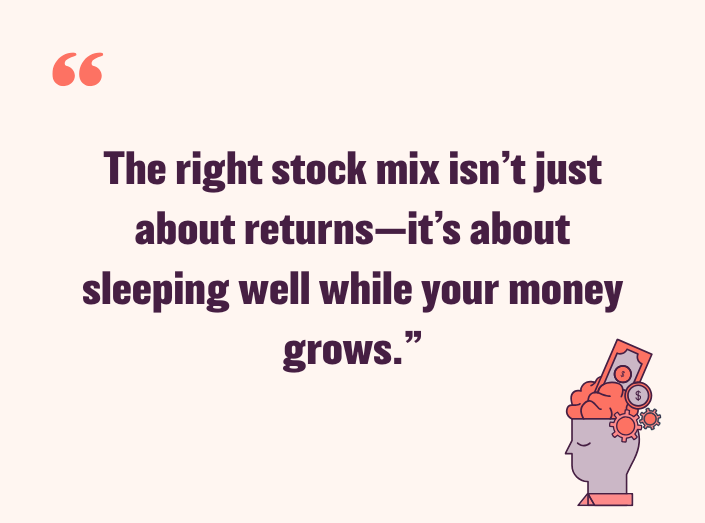Let’s be honest—figuring out how much to invest in stocks can feel confusing
If you’ve started building a portfolio or even just thinking about it, one big question comes up quickly:
How much of my portfolio should be in stocks?
The answer isn’t the same for everyone, but it’s one of the most important decisions you’ll make as an investor. Too much in stocks, and you might feel anxious when the market dips. Too little, and your money might not grow fast enough to reach your goals.
The good news? There are some clear guidelines to help you make the choice that fits your life, your personality, and your long-term plans.

Why stocks matter in a portfolio
Stocks—or equities—represent ownership in a company. When you invest in stocks, you’re buying a small piece of a business, with the potential to earn returns through share price growth and sometimes dividends.
Over the long term, stocks have historically delivered stronger returns than most other asset classes. That’s why they’re often the growth engine of an investment portfolio.
But here’s the trade-off: stocks are more volatile. They can swing up or down in value more than bonds or cash-based investments. So the key is knowing how much stock exposure you can handle—not just financially, but emotionally too.
A classic starting point: the "100 minus your age" rule
One common rule of thumb is this: subtract your age from 100, and that’s the percentage of your portfolio you might hold in stocks.
So if you’re 30, you’d consider holding around 70 percent in stocks. If you’re 60, perhaps closer to 40 percent.
The idea is simple: the younger you are, the more time you have to ride out the market’s ups and downs. As you get older, it makes sense to reduce risk and shift towards more stable investments.
Of course, this is just a starting point—not a rule carved in stone.

What really matters when deciding your stock allocation
There are a few key questions to help you figure out what works best for you.
What’s your goal?
Are you investing for retirement 30 years from now? Or planning to use the money in five years? Longer timelines usually allow for a higher percentage in stocks because you can afford to wait out short-term dips.
What’s your risk comfort level?
Some people can shrug off market drops. Others lose sleep when their balance goes down. If you’re someone who’s more cautious by nature, you might prefer a smaller share in stocks, even if you’re young.
Do you need income or growth?
If your goal is to grow your money over time, stocks will likely play a bigger role. But if you’re looking for regular income (for example, in retirement), you might favour bonds or dividend-paying investments.
Are you investing alone or with a partner?
Sometimes couples balance each other out. One might prefer a bolder approach, the other something safer. It’s worth having the conversation to align your strategies if your finances are shared.

Avoid going to extremes
Putting 100 percent of your money in stocks might sound exciting—especially when markets are rising—but it comes with risk. A single market crash could set your goals back years if you need to withdraw at the wrong time.
At the same time, keeping everything in cash or bonds might feel safe, but over long periods, your returns could be too low to meet your goals.
The sweet spot is different for each person. What matters most is building a mix that helps you stay invested even when markets feel shaky.
Still unsure? Let technology do the heavy lifting
If you’re not confident choosing your own stock allocation, there’s good news. Many investment platforms and apps now do this for you. They ask a few questions about your age, goals, and risk tolerance, then build a diversified portfolio with the right mix of stocks, bonds, and other assets.
You don’t need to be an expert—you just need to get started with the right tools.

Final thoughts: it’s all about balance
There’s no single answer to the question how much of my portfolio should be in stocks. It’s personal. It’s flexible. And it can change as your life changes.
Stocks are a powerful part of long-term investing—but only if you’re comfortable with them. The right balance is one that helps you grow your money without keeping you up at night.
So start with your goals, listen to your instincts, and adjust as you go.
Build your ideal stock allocation today
Download our free app and let us help you find the right balance for your investment goals.
You’ll get a personalised portfolio, expert-built strategy, and tools to adjust your stock allocation as life changes. No jargon. No pressure. Just smart investing made simple.
👉 Download the app now and take control of your portfolio with confidence
Because good investing starts with a plan that fits you—not someone else’s idea of perfect.